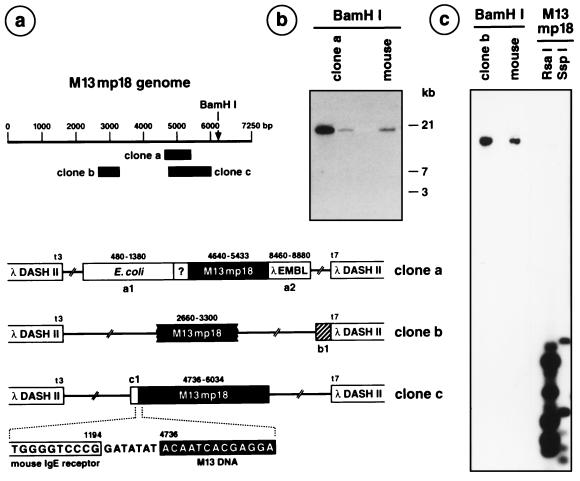Figure 5.
Recloning of M13mp18 DNA from spleen DNA of mice fed with M13mp18 DNA. In brief, the segments of M13mp18 DNA present in the DNA of the M13mp18 DNA-positive recombinant λ clones were identified by hybridizing the 32P-labeled recombinant λ DNA to RsaI- or SspI-cleaved M13mp18 DNA (e.g., c, right lanes). On the basis of the known nucleotide sequence of M13mp18 DNA (19), primers were selected and the exact M13mp18 DNA represented was determined. By using primers from the known M13mp18 DNA (solid boxes in a), the adjacent nucleotide sequences were determined and identified by computer-aided National Center for Biotechnology Information searches. The λDASHII clone a was derived from feeding experiment ii, the clones b and c from the schedule iii experiment. (a) Map of the linearized M13mp18 genome. The locations of the nucleotide sequence-identified M13mp18 segments present in λDASHII clones a–c are indicated as solid blocks. In clone a, a1 represents the Escherichia coli DNA sequence of an ATP-dependent Clp-protease, the question mark a sequence of unknown, possibly mouse, origin. The segment a2 carries rearranged DNA from the left arm of λ DNA. In clone b, the DNA sequence shown as a hatched segment b1 exhibits homologies to mouse DNA (129/sv Clora cell 10 kDa, mCC10 gene). (b) Clone a DNA was 32P-labeled by nick-translation and hybridized to BamHI-restricted clone a DNA or genomic mouse DNA on a Southern blot under stringent hybridization (68°C, 2 × SSC) and wash conditions (68°C, 2 × 15 min with 2 × SSC, 0.1% SDS; 2 × 25 min with 0.2 × SSC, 0.1% SDS). (c) A similar experiment for clone b DNA, which is also shown to hybridize to m13mp18 DNA and to genomic mouse DNA. The 80 bp DNA segment in c1 was 70% homologous to the mouse IgE receptor gene.

